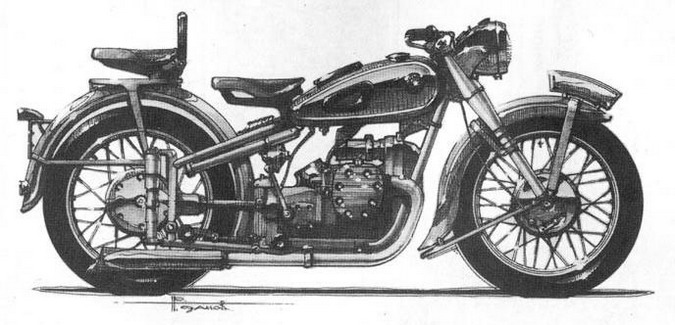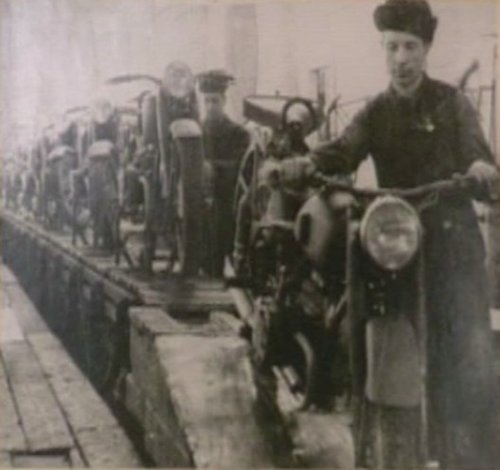No products available yet
Stay tuned! More products will be shown here as they are added.
Irbit is a city in Sverdlovsk Oblast, Russia. The geographic coordinates are: 57.67 degrees north, 63.06 degrees east. Irbit is about 200 km from Ekaterinburg.
In the West, Irbit is primarily known as the location of the Irbiter Motorradwerke, which sells its products under the trade name Ural.
In addition to the motorcycle factory, Irbit has another notable factory that produces special glass.
The history of the Urals began at a secret meeting of the Ministry of Defence of the USSR.
The question was which motorcycle was best used for use in the Soviet army. After a long discussion, the BMW R 71 was chosen.
As a result, five R71s were purchased, thoroughly disassembled and recreated in Sweden. The result was presented to Comrade Stalin with the name M72 (M like Comrade Molotov)* and the serial production was decided.

Almost all the components of the R71 meant new territory for Soviet industry. The two-cylinder boxer engine, the welded tube frame the straight-way - rear suspension and the gimbal drive have not been used on the local motorcycles.


The production of many parts required new technologies and machines, which had to be produced with difficulty, The plants destined for the production of the new motorcycle could not produce all the parts themselves. Production orders for specific assemblies were also distributed to other factories. Aluminium castings, transmission parts and the telefork came, for example, from the ZIS automotive plant in Moscow and the various automobile plants in Gorky- today Nishnij-Novgorod.
The Moscow factory brought it to 1753 motorcycles before it was also evacuated. The production facilities have now been relocated to the Siberian town of IRBIT, behind the Ural Mountains, more than 1200 km east of Moscow.
The factory IMZ Irbitskij Moto-Zawod sent the first motorcycles to the front at the end of February 1942. The two plants in Irbit and Gorkij were still supplied with many components from other factories, which always led to difficulties during final assembly and resulted in a very different level of quality.
In the summer of 1942, not a single motorcycle ready for driving could be delivered, as there were simply no more usable parts arriving at the plants. In 1942/43 a total of 3780 motorcycles were produced in Irbit and 2694 m72 in Gorkyj.
During world war ii, 9799 motorcycles were delivered for use on the front.
After the Great Patriotic War, the factory was further expanded and in 1950 the 30,000th motorcycle was produced.
It was not until 1958 that production of the good old M-72 settled. In 1960, the still unchanged wheel-wheel-loaded frame was given a head-controlled engine, the M-60.
M-61,M-63,M-66,M-67 were the model names of the 1960s, which were constantly improved. (shock absorber spring frame; 12 volt electrics etc.
To date, more than three million motorcycles have been built, mostly with sidecars.
Exports began in 1953, initially mainly to so-called developing countries. In the late 1980s, worldwide interest in the classic and inexpensive teams began.
At the end of the 1970s, production was in full swing.
In 1998, the state-owned company was privatized.
With the introduction of the 750 cc models in 2001, an important step was taken in model policy. The 40 hp now available allows drivers not to rely on truck windshadow shadevens even on motorway stages. The processing of the new models had improved a lot and the motorcycles were equipped with Japanese KEIHINcarburetors, K&N air filter insert and necessary catalytic converters.
For the models since 2008, an SLS system ensures state-of-the-date exhaust emissions. The electronic ignition system from DUCATI ENERGIA ensures the right ignition spark. The paintwork is flawless thanks to Western paints and the handlebar fittings, trains, levers and much more are of Italian origin.
The alternator is now DENSO , the shock absorbers are installed by ZF SACHS and all gears (engine, gearbox) are delivered by the German company HERZOG to the Russian Irbit in order to be installed in the Ural teams. All bearings, shaft seals, screws, nuts, cables, electrical connectors on the trailer are of Western origin. A BREMBO disc brake system on the front wheel ensures a good braking delay. All wheels have aluminium rims from 2011. These many improvements ensure that the Ural team is now a very reliable and everyday vehicle.
In the crisis year 2009, the Ural plant produced only 500 motorcycles. For environmental reasons, the plant has had to close its own galvanic department. The workforce has been reduced to 150 people.
In 2010 there was again an increase in production, and by the end of the year 800 motorcycles will leave the factory.
1300 motorcycles are planned for 2011.
The main sales market is the USA, two-thirds of the total production goes to the USA. In addition to Europe, motorcycles are also delivered to Canada, Australia, Japan, South Africa. Very few Ural teams are sold in Russia itself.
Camouflage beige-beige-brown. Has quickly taken first place in the Rangers' popularity scale when it was introduced in 2011. The Gobi is not so much military-inspired, is somehow milder in appearance.
Ural Retro M70
On November 19, 1941, the first train with machines, tools and parts for the production of motorcycles arrived in Irbit, a small town 300 km east of the foothills of the Ural Mountains. Just a month earlier, it was decided to evacuate the Moscow motorcycle factory from the imminent threat of an attack by German troops. Long years of war followed. The relocated motorcycle factory had the task of producing heavy off-road motorcycles and teams for use in the war. This is how the history of the Irbiter Motorrad Plant (IMZ) began. The motorcycle was called M72. The first copies from Irbit were completed in mid-1942. Nearly 9,500 units of M72 were manufactured by the Red Army until 1945. There were many women and also children who assembled motorcycles for the war front in western Siberia to help fend off the enemy. No idea for these workers that your motorcycle factory still exists 70 years later, is the only team factory in the world and that the motorcycle with sidecar Ural has become a cult.
Since 1941, more than 3 million motorcycles have been produced in the Irbit motorcycle factory. On 19 November 2011, the Irbiter Motorradwerk celebrates its 70th birthday and presents the anniversary model Ural M70. It is dedicated to the pioneers among the workers and engineers of the Irbit motorcycle factory from the time of the Second World War.
It is meant to be closely reminiscent of the original in the details, so only the Retro model is considered as a base vehicle.
An attempt was made to take over the colour scheme of the anniversary model M70 from the M72 from the war years. The material and colour of the sidecar cover is almost identical to the original from the 1940s. A machine gun holder is integrated on the sidecar. There is also a reunion with the old red round IMZ logo on the tank. It was reissued for the anniversary model.
Today, the Irbiter Motorradwerk produces and sells around 100 sidecar motorcycles per month, i.e. around 1200 units per year. The main market is the USA, where half of total production goes. About 300 units are sold annually in Europe, where France and Germany are the largest customers, each with 80 to 100 units per year.

Stay tuned! More products will be shown here as they are added.